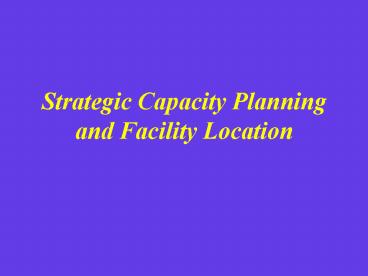Strategic Capacity Planning and Facility Location - PowerPoint PPT Presentation
1 / 28
Title:
Strategic Capacity Planning and Facility Location
Description:
Title: Strategic Capacity Planning and Facility Location Author: Mick Peters Description: Chapter 8 of C & A Last modified by: Kimball Bullington Created Date – PowerPoint PPT presentation
Number of Views:189
Avg rating:3.0/5.0
Title: Strategic Capacity Planning and Facility Location
1
Strategic Capacity Planning and Facility Location
2
Strategic Capacity Planning
- What Size Should the Operations System Be?
3
Capacity Problems
- Movie theaters
- Electrical energy-California
4
Capacity
- Amount of resource inputs available relative to
output requirements at a particular time - Some measurements of capacity
- Output rate capacity
- Aggregate capacity
- Input rate capacity
- Percentage of capacity utilization
- Strategic capacity planning specifies the overall
capacity level of resources that best supports
the firms long range competitive strategy
5
Capacity Planning
- Considerations in Changing Capacity
- Alternatives When Changing Capacity
- Determining Capacity Requirements
6
Considerations inChanging Capacity
- Maintaining System Balance
- Frequency of Capacity Changes
- External Sources of Capacity
- Subcontractor networks
- Sharing capacity
- Supplier networks
7
Expansion of Long-Term Capacity
- Subcontract
- Acquire capacity
- Develop new sites
- Expand current sites
- Reactivate standby facilities
8
Reduction of Long-Term Capacity
- Sell off existing facilities
- Mothball facilities
- Develop and phase in new products/services
9
Steps in theCapacity Planning Process
- Estimate the capacity of the present facilities
- Forecast the long-range future capacity needs
- Identify and analyze sources of capacity to meet
these needs - Select from among the alternative sources of
capacity
10
Forecasting Capacity Demand
- Long-range forecast of market demand
- Estimate the firms market share
- Multiply the forecasted market demand by the
estimated market share - Adjust for utilization and efficiency factors
- Translate firms demand into machine and labor
capacity needs
11
Importance of Capacity Decisions
- Impact the ability of the firm to meet future
demands for products and services - Affect operating costs
- Usually a major determinant of initial cost
- Involves long-term commitment of resources and
difficult to modify - Affect competitiveness
12
Types of Capacity
- Design capacity
- maximum obtainable output
- Effective capacity
- Maximum capacity given product mix, scheduling
difficulties, and other doses of reality. - Actual output
- rate of output actually achieved--cannot exceed
effective capacity.
13
Efficiency and Utilization
Actual output Efficiency Effective
capacity Actual output Utilization
Design capacity
14
Efficiency/Utilization Example
- Design capacity 50 trucks/day
- Effective capacity 40 trucks/day
- Actual output 36 units/day
- Actual output 36 units/day
- Efficiency 90
- Effective capacity 40
units/ day - Actual output
36 units/day Utilization
72 - Design capacity
50 units/day
15
Optimal Output Rate
Production units have an optimal rate of output
for minimal cost.
Average cost per unit
Minimum cost
0
Rate of output
16
Minimum cost optimal operating rate are
functions of size of production unit
Small facility
Average cost per unit
Medium facility
Large facility
0
Output rate
17
Other Considerations
- Resource availability
- The experience curve
- Focus
- Flexibility
- Economies of scope
- Accuracy of the long-range forecast
- Capacity cushion
- Changes in competitive environment
18
Decision Approaches
- Break-even Analysis
- Present-value Analysis
- Decision Tree Analysis
- Computer Simulation
- Waiting Line Analysis
- Linear Programming
19
Planning Service Capacity
- Timing
- Services cannot be stored for later use
- Capacity must be available to produce a service
at the time when it is needed - Location
- For high contact services, capacity must be
located near the customer - Volatility of Demand
- Services cannot be stored
- Customers interact directly with the system and
each may have different requirements - Directly affected by consumer behavior
20
Facility Location
21
Some Reasons the Facility Location Decision
Arises (1 of 2)
- Changes in the market
- Expansion
- Contraction
- Geographic shift
- Changes in inputs
- Labor skills and/or costs
- Materials costs and/or availability
- Utility costs
22
Reasons (2 of 2)
- Changes in the environment
- Regulations and laws
- Attitude of the community
23
Characteristics of the Facility Location Decision
- Infrequent
- Expensive to implement
- Studied and evaluated extensively
- Determination of a site involves narrowing the
scope of the area being considered - Involves a long-term commitment
24
Some Factors Affecting the Location Decision (1
of 2)
- Economic
- Site acquisition, preparation and construction
costs - Labor costs, skills and availability
- Utilities costs and availability
- Transportation costs
- Taxes
25
Factors (2 of 2)
- Noneconomic
- Proximity to customers
- Labor attitudes and traditions
- Training and employment services
- Communitys attitude
- Schools and churches
- Recreation and cultural attractions
- Amount and type of housing available
- Political risk
- Location of other facilities
26
Analyzing Service Location Decisions
- Consumer behavior research
- Market research
- Data gathering for each location alternative
- Revenue projection for each location alternative
- Profit projection for each location alternative
27
Examples of Decision Approaches
- Break-even Analysis
- Rating Scale
- Relative-Aggregate-Scores
- Present-value Analysis
- Cost Minimization Models
- Center of gravity method
- Decision Tree Analysis
- Computer Simulation
- Linear Programming
28
(No Transcript)































